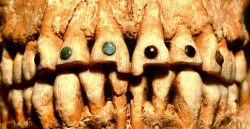Anthropology
Related: About this forumAn ancient Maya ambassador's bones show a life of privilege and hardship
Last edited Tue Mar 16, 2021, 02:02 AM - Edit history (1)
15-MAR-2021
Ajpach' Waal forged an alliance between two dynasties but died in obscurity
UNIVERSITY OF CALIFORNIA - RIVERSIDE

IMAGE: TEETH WITH DENTAL INLAYS FROM A NONROYAL ELITE MAYAN TOMB.
CREDIT: KENICHIRO TSUKAMOTO
An important Maya man buried nearly 1,300 years ago led a privileged yet difficult life. The man, a diplomat named Ajpach' Waal, suffered malnutrition or illness as a child, but as an adult he helped negotiate an alliance between two powerful dynasties that ultimately failed. The ensuing political instability left him in reduced economic circumstances, and he probably died in relative obscurity.
During excavations at El Palmar, a small plaza compound in Mexico near the borders of Belize and Guatemala, archaeologists led by Kenichiro Tsukamoto, an assistant professor of anthropology at UC Riverside, discovered a hieroglyph-adorned stairway leading up to a ceremonial platform. When deciphered, the hieroglyphs revealed that in June, 726 CE, Ajpach' Waal traveled and met the king of Copán, 350 miles away in Honduras, to forge an alliance with the king of Calakmul, near El Palmar.
The findings, published in the journal Latin American Antiquity, shed light on the role communities peripheral to major centers played in cementing connections between royal families during the Late Classic period (600-800 CE), and the ways they might suffer when something shattered those alliances.
The inscriptions identified Ajpach' Waal as a "lakam," or standard-bearer, an ambassador that carried a banner as they walked on diplomatic missions between cities. He inherited this lofty position through his father's lineage, and his mother also came from an elite family. Ajpach' Waal must have considered this his crowning achievement because the hieroglyphs indicate he was not given the platform by El Palmar's ruler, but had it built it for himself a few months after the mission in September, 726 CE. The platform served as a sort of theatrical stage where spectacular rituals were performed for an audience, with only influential people able to build their own.
More:
https://www.eurekalert.org/pub_releases/2021-03/uoc--aam031521.php
~ ~ ~ ~ ~
Looked for a photo of jewel-inlaid Mayan teeth:

Dental Modifications of Ancient Maya and Other Civilizations (Part Two)
Posted on August 6, 2013 by Dr. Gray
The jewel inlays, mentioned in Part 1 of this series, are the type of dental modification that most closely resembles today’s fads. Similar to “grills” or other forms of “tooth jewelry,” the inlays of the Ancient Maya required exquisite skill and craftsmanship. This technique is thought to have begun in the Pre-Classic (100 BC-300 AD). However, the more elegant tooth alterations occurred much more recently, sometime between 700 and 900 AD. The stones commonly used to highlight the teeth of these Mayan men, women, and children included pyrite, jadeite, turquois, hematite, quartz, serpentine, and cinnabar.
Joel B. Schilling, DDS, says that the Ancient Maya used powdered quartz in water as an abrasive while drilling holes for these inlays. They spun a round, hard tube between the hands or in a rope drill to cut a round indention into the tooth enamel. It’s also been suggested that a thin, sharpened animal bone that had been hardened by fire was used. Either way, after the hole was made the inlay was cemented into place.
“Head Shaping and Dental Decoration Among the Ancient Maya: Archeological and Cultural Aspects,” by Vera Tiesler, states that dental modification was slightly more common among females, with about 65 percent of females having modified teeth compared to roughly 58 percent of males. Also, based on archaeological findings it appears that roughly 60 percent of them engaged in some form of dental modification, and more than fifty different patterns have been identified within Ancient Maya culture.
In fact, there is an outstanding collection of over 1,200 teeth adorned at the Instituto Nacional de Anthropologia e Historia in Mexico City. Romero Molina, of the INAH, so far has found 62 different patterns of teeth and organized these patterns into 7 different categories. Most of these teeth have come from Middle America, with only 3 coming from South America and 3 coming from North America. In addition to the different patterns of individual teeth, Molina also discovered that the teeth would sometimes be combined to form specific patterns in the jaw to add to the overall visual effect.
More:
https://santarosadentist.wordpress.com/2013/08/06/dental-modifications-of-ancient-maya-and-other-civilizations-part-two/